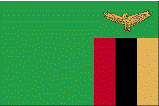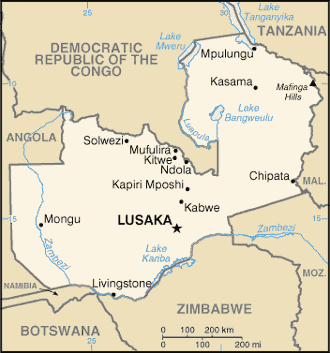|
Zambia
|

|
Capital: Lusaka
Population: 17,861,030
Brief History of Zambia:
Zambia was originally inhabited by hunter-gatherer tribes thousands of years ago. In the 15th century Bantu speaking tribes people migrated into the area.
It wasn't until the middle of the 1800s that Europeans began to explore the area. David Livingstone visited in 1855 and found the waterfalls on the Zambezi River. He named them Victoria Falls.
In 1924 Zambia, which was called Northern Rhodesia at the time, came under British control. In 1953, it was combined with Southern Rhodesia and Malawi to form the Federation of Rhodesia and Nyasaland. Finally, in 1964, Zambia became an independent country.
The Geography of Zambia
Total Size: 752,614 square km
Size Comparison: slightly larger than Texas
Geographical Coordinates: 15 00 S, 30 00 E
World Region or Continent: Africa
General Terrain: mostly high plateau with some hills and mountains
Geographical Low Point: Zambezi river 329 m
Geographical High Point: unnamed location in Mafinga Hills 2,301 m
Climate: tropical; modified by altitude; rainy season (October to April)
Major cities: LUSAKA (capital) 1.413 million (2009)
The People of Zambia
Type of Government: republic
Languages Spoken: English (official), major vernaculars - Bemba, Kaonda, Lozi, Lunda, Luvale, Nyanja, Tonga, and about 70 other indigenous languages
Independence: 24 October 1964 (from UK)
National Holiday: Independence Day, 24 October (1964)
Nationality: Zambian(s)
Religions: Christian 50%-75%, Muslim and Hindu 24%-49%, indigenous beliefs 1%
National Symbol: African fish eagle
National Anthem or Song: Lumbanyeni Zambia (Stand and Sing of Zambia, Proud and Free)
Economy of Zambia
Major Industries: copper mining and processing, construction, foodstuffs, beverages, chemicals, textiles, fertilizer, horticulture
Agricultural Products: corn, sorghum, rice, peanuts, sunflower seed, vegetables, flowers, tobacco, cotton, sugarcane, cassava (tapioca), coffee; cattle, goats, pigs, poultry, milk, eggs, hides
Natural Resources: copper, cobalt, zinc, lead, coal, emeralds, gold, silver, uranium, hydropower
Major Exports: copper/cobalt 64%, cobalt, electricity; tobacco, flowers, cotton
Major Imports: machinery, transportation equipment, petroleum products, electricity, fertilizer; foodstuffs, clothing
Currency: Zambian kwacha (ZMK)
National GDP: $21,880,000,000
** Source for population (2012 est.) and GDP (2011 est.) is CIA World Factbook.
Back to Geography Home Page
